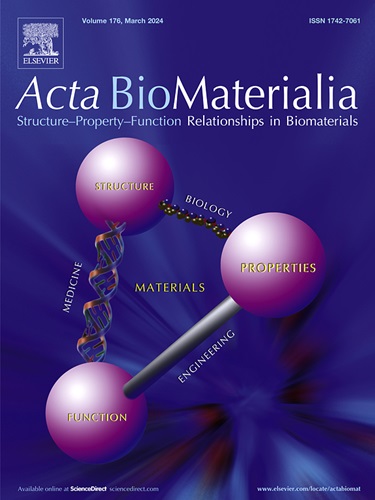脱氧羟基磷灰石通过限制纤维连接蛋白的吸附抑制巨噬细胞炎症。
IF 9.4
1区 医学
Q1 ENGINEERING, BIOMEDICAL
引用次数: 0
摘要
巨噬细胞可以决定异物反应(FBR)的最终结果。尽管研究人员证实,植入物界面元素组成的差异会导致不同程度的生物功能,但不同氧比例诱导巨噬细胞极化方向的机制仍不清楚。本研究介绍了脱氧羟基磷灰石(dHAP)表面的制作过程,以研究氧含量对巨噬细胞活化的影响。与 HAP 表面相比,dHAP 表面对巨噬细胞的炎症活化具有明显的抑制作用。全内反射显微镜(TIRFM)和分子动力学(MD)模拟结果表明,细胞外基质的重要粘附蛋白纤连蛋白(Fn)在 dHAP 表面的吸附水平较低。Arg-Gly-Asp(RGD)结构域的暴露量减少。Fn 粘附能力的降低和活性位点识别能力的减弱导致 dHAP 表面巨噬细胞整合素-病灶粘附激酶(FAK)通路的活化程度降低,从而抑制了炎症。总之,这项工作在蛋白质水平上解释了氧比例对 FBR 的影响机制。它还介绍了一种提高生物材料兼容性的新方法。重要意义:--修订版 巨噬细胞是异物反应(FBR)的关键。研究表明,植入材料的元素界面含量可以调节生物材料的功能,但这种调节机制尚不清楚。为了研究 FBR 中界面元素含量与巨噬细胞之间的关系,我们制备了一种脱氧羟基磷灰石(dHAP)。我们的结果表明,dHAP 表面抑制了 ECM 蛋白--纤连蛋白(Fn)的吸附行为并改变了其取向,同时暴露出的 Arg-Gly-Asp (RGD) 序列活性位点较少,从而导致整合素活化程度降低。然后,整合素-焦点粘附激酶(FAK)信号通路的激活减少,导致巨噬细胞朝着有利于再生的方向进一步激活。本文章由计算机程序翻译,如有差异,请以英文原文为准。

Deoxygenated hydroxyapatite inhibits macrophage inflammation through fibronectin restricted adsorption
Macrophages can determine the ultimate outcome of the foreign body reaction (FBR). Although researchers confirmed that differences in the elemental composition of the implant interface can lead to varying levels of biological function, the mechanism underlying the polarization directions of macrophages induced by varying oxygen proportions remains unclear. This research presented the fabrication of a deoxygenated hydroxyapatite (dHAP) surface to investigate the impact of oxygen content on macrophage activation. The dHAP surface exhibited a pronounced inhibitory effect on the inflammatory activation of macrophages when compared to the HAP surface. Results from total internal reflection microscopy (TIRFM) and molecular dynamic (MD) simulation have revealed that the significant extracellular matrix adhesion protein, Fibronectin (Fn), showed a lower level of adsorption on dHAP surfaces. The Arg-Gly-Asp (RGD) structural domain showed a reduction in the exposure. The diminished adhesion capacity and impaired active site recognition ability of Fn resulted in lower activation of the integrin-focal adhesion kinase (FAK) pathway of macrophages on the dHAP surface, thereby suppressing the inflammation. In summary, this work explains the mechanism of the FBR impacted by the proportion of oxygen at the protein level. It also introduces a new approach to enhance the compatibility of biomaterials.
Statement of Significance
Macrophages are key in the foreign body response (FBR). Researches indicate that implant material's elemental interface content can regulate the functionality of biomaterials, but the mechanism of this regulation is unclear. To study the relationship between the elemental content at the interface and macrophages in the FBR, we prepared a deoxygenated hydroxyapatite (dHAP). Our results showed that the dHAP surface inhibited the adsorption behavior and changed the orientation of an ECM protein—fibronectin (Fn)—as well as the exposure of fewer active sites of the Arg-Gly-Asp (RGD) sequence, leading to less integrin activation. And then, the activation of the integrin- focal adhesion kinase (FAK) signaling pathway was reduced, leading to a greater activation of macrophages towards a pro-regenerative direction.
求助全文
通过发布文献求助,成功后即可免费获取论文全文。
去求助
来源期刊

Acta Biomaterialia
工程技术-材料科学:生物材料
CiteScore
16.80
自引率
3.10%
发文量
776
审稿时长
30 days
期刊介绍:
Acta Biomaterialia is a monthly peer-reviewed scientific journal published by Elsevier. The journal was established in January 2005. The editor-in-chief is W.R. Wagner (University of Pittsburgh). The journal covers research in biomaterials science, including the interrelationship of biomaterial structure and function from macroscale to nanoscale. Topical coverage includes biomedical and biocompatible materials.
 求助内容:
求助内容: 应助结果提醒方式:
应助结果提醒方式:


